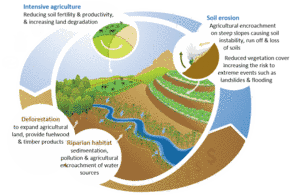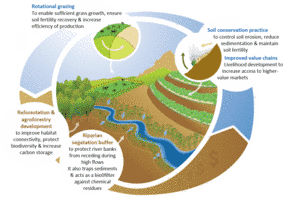Building an IES package
Step 1: Map and assess current ecosystem services and socioeconomic context
For this, the area of intervention needs to be defined, including:
- Defining ecosystem type and scale of focus
- Mapping the current use and users of ecosystem services to identify economic, ecological and social values associated with ecosystem services
- Identify and map threats to ecosystem services
- Map existing national regulations in place to address these threats
Key questions to ask
Key questions to ask
- What is the current state of the ecosystem?
- Who are the ecosystem users? How do they use the ecosystem?
- What are the perceived threats?
- What are the regulations in place to prevent these threats? (How) Are they enforced?
- What other national regulations currently exist to govern ecosystem services and agricultural practices? (How) Are they enforced?
Expertise needed
Expertise needed
- Ecosystem services and agriculture expert to define the threats and possible mitigation methods through agriculture and conservation activities
- Facilitator to lead stakeholder discussion to understand ecosystem services values and identify threats
Step 2: Identify best agricultural and conservation practices to address threats to ecosystem services
Key questions to ask
Key questions to ask
- Which farming practices could improve this problem, or protect this ecosystem services value:
- For conservation?
- For improved productivity?
- For improved livelihoods?
Step 3: Identify barriers to adoption
- Identify the barriers for farmers to adopt best practices identified in Step 2
Key questions to ask
Key questions to ask
- What are the barriers for farmers to adopt these practices?
- Technical
- Financial
- Cultural
- Legal (enforcement of regulations, tenure issues)
- Institutional (ownership, negotiation, trust)
- Administrative
- Equity (access to resources, benefit sharing)
- What are the limiting factors to improving productivity?
Step 4: Identify incentives required to support farmers implement sustainable agricultural practices
Identify the short- and long-term incentives required to support farmers overcome adoption barriers identified in Step 3 for readiness, implementation and sustainability of best practices
Key questions to ask
Key questions to ask
- What are the incentives farmers require and/ or would require to overcome the adoption barriers identified in step 3 and/ or reward good environmental stewardship?
- Type: Financial, in-kind, technical, etc.
- For what activity?
- At what stage are these incentives required?
- Readiness
- Implementation
- Sustainability
Step 5: Define monitoring needs
- Define and develop indicators and monitoring to track impact of incentives and activities for:
- Socioeconomic outcomes (increased productivity, livelihood improvement, food security)
- Environmental outcomes (conservation, restoration of landscapes, protection of sensitive habitats)
Key questions to ask
Key questions to ask
- What outcomes will be key to monitor to track impact of incentives and activities:
- Social
- Economic
- Environmental
- Food security (availability, access, utilisation and stability), nutrition
- Gender
- Equity of benefit distribution
- Resilience (climate change, pests/ diseases, market changes)
- What indicators and methods are required to monitor these outcomes? i.e. No impact, Tier 1, Tier 2, Tier 3.
- Who will/ can feasibly collect, collate and analyse monitoring data? [N.B. this may influence which indicators and methods are used, whether training is needed, etc.]
- What existing monitoring is currently in place that could be used to in-build these indicators?
Step 6: Institutional mapping
To identify:
- Short- and long-term incentives currently provided by existing public programmes and private sector investment
- Synergies and gaps for financing incentives
- Opportunities to engage with public programmes and private sector investments that have the potential to provide incentives
Key questions to ask
Key questions to ask
Institutional mapping:
- What existing incentives are currently provided from:
- Public programmes?
- Private sector investment?
- What type of incentives do they provide and what practices do they support?
- Who can access these incentives?
- What is the process for farmers to access the incentives offered?
- Are there perverse/ negative incentives that conflict with conservation and sustainable production objectives?
- What is the conditionality (if any?) for farmers to receive incentives?
- Mode: Input/ output based
- Frequency of incentive/ reward: Upon compliance/ periodically/ once
- Enforcement of conditionality (if any)
- How are incentives and their activities monitored?
Synergies and gaps:
- What additional incentives are needed:
- At different stages (readiness, implementation, sustainability)?
- To overcome/ compensate negative externalities of conservaiton (e.g. human-wildlife conflict), if any?
- Where can incentives be used together to support a wider sustainable landscape approach? For different stages:
- Readiness: Restoration and conservation of degraded ecosystems, e.g. reforestation, terracing
- Implementation: Sustainable agricultural practices, e.g. organic fertilizers, improved varieties
- Sustainability: Access to higher-value markets/ value chain development, livelihood diversificationI
- How can a conditional link be built between conservation and improved productivity activities?
Engagement opportunities:
- Where is the political entry point/ is there a trusted institution that could coordinate multiple incentives and enforce their conditionality?
- What opportunities are there for potential financing of incentives from additional public programmes and private sector engagement (throughout stages)?
Step 7: Develop an enabling environment to implement a more coordinated approach
Support the improvement of policies to facilitate the development and support the implementation of IES packages, through:
- Review current policies and identify conflicts, bottlenecks and scope for improvement
- Raise awareness of policy- and decision-makers (through meetings, workshops, side events, etc.)
- Policy brief redaction
Key questions to ask
Key questions to ask
Improving coordination:
- What are the policies or institutions that can facilitate, or block, the coordination of agri-environmental institutions?
- How can such blockages be overcome?
- What institutions or initiatives could be used as an umbrella initiative to facilitate a more coordinated approach?
- What policy or institutional changes are required to support greater integration of private sector investment?
Integrating public policies and private sector investment:
- How can private sector investment be integrated into the financing of an IES package?
- What is needed to enable their engagement?
- What policy blockages may prevent this?
- What institutions/ regulations can facilitate or support this?
- What are the financial mechanisms that IES can offer to facilitate the transfer of resources between different administrative areas, public sectors and private initiatives?
- What policy or institutional changes are required to suport greater integration of private sector investment?
- What coordination is required?



